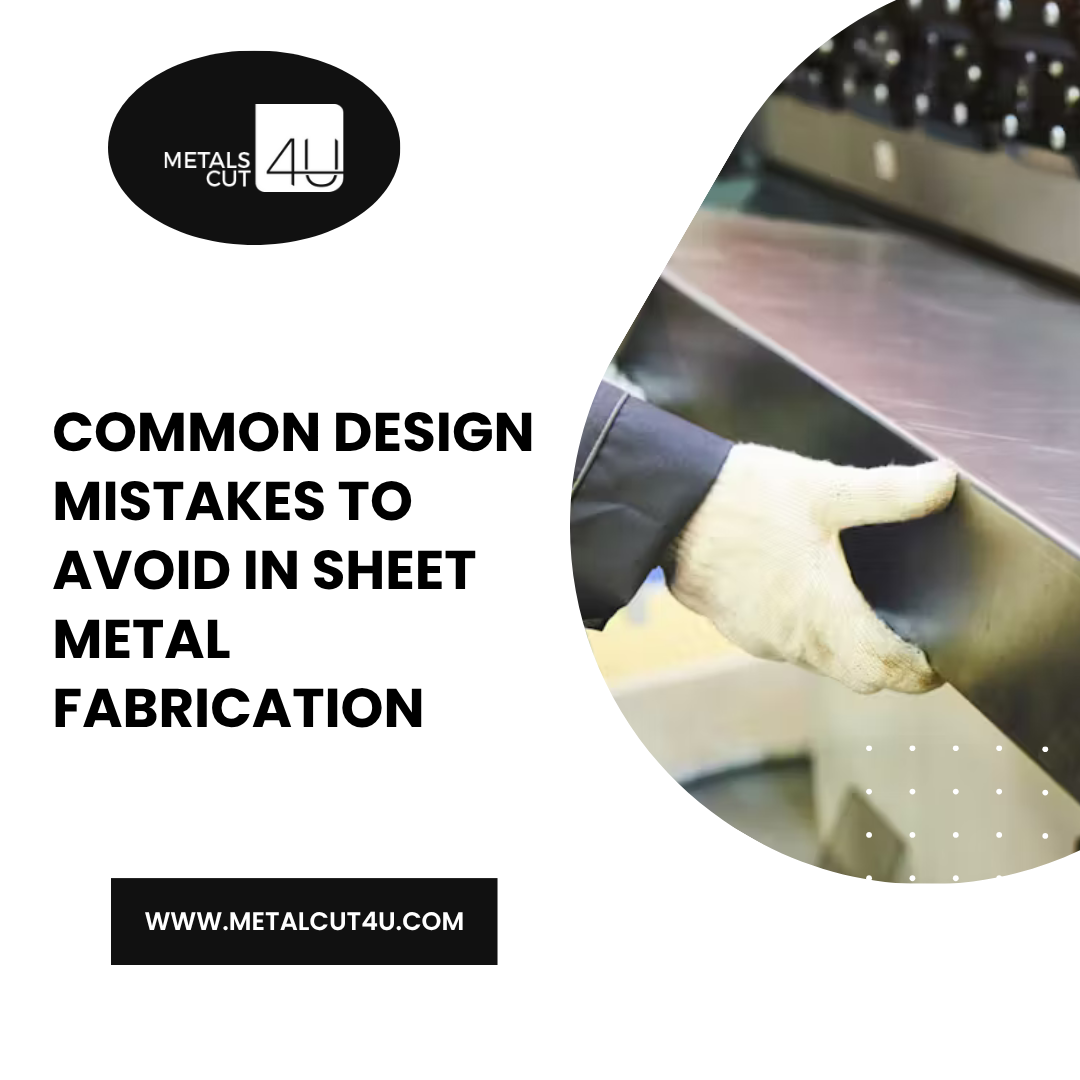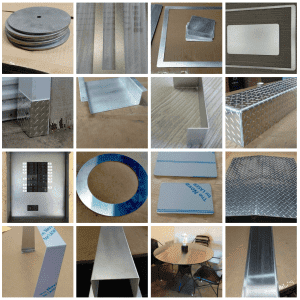Common Design Mistakes to Avoid in Sheet Metal Fabrication

Common Design Mistakes to Avoid in Sheet Metal Fabrication
Sheet metal fabrication is a crucial component of manufacturing for a diverse range of industries, including construction and aerospace. However, while the process may seem straightforward on paper, minor design oversights can turn into major setbacks during production. These common sheet metal fabrication mistakes can lead to costly reworks, compromised quality, and even structural failures.
In this blog, we’ll walk through the most common issues that engineers and designers encounter, explore sheet metal design guidelines, and share actionable steps you can take to ensure your design is fabrication-ready.
Understanding the Basics of Sheet Metal Fabrication
Before diving into the sheet metal fabrication mistakes, it's crucial to understand what the process involves. Sheet metal fabrication is the process of cutting, bending, and assembling flat sheets of metal into desired shapes. These processes rely on a mix of manual techniques and automated tools, including laser cutters, press brakes, and CNC machines.
The entire sheet metal manufacturing process involves multiple stages, including designing, prototyping, testing, and production. Each of these stages must align with sheet metal design guidelines to avoid preventable issues.
Key sheet metal fabrication techniques include:
-
Laser cutting for precise, clean edges.
-
Bending and forming create geometries that optimize structural strength.
-
Punching and notching for features and connections.
-
Welding and assembly are used to complete the final product.
Even with advanced tools and experienced local metal fabricators, design flaws can lead to failures if not caught early.
Common Mistakes to Avoid in Sheet Metal Fabrication
Let’s take a closer look at the most common sheet metal fabrication mistakes and how you can avoid them in your design process.
-
Ignoring Bend Radii and K-Factors
One of the most overlooked areas in sheet metal fabrication is the improper consideration of bend radii. Failing to factor in correct bend allowances can lead to material cracking or warping.
Each material has a minimum bend radius, which is typically related to its thickness. If you bend the metal too sharply without considering this, you risk developing structural weakness. Similarly, K-factor, a value that determines how the material will stretch when bent, is often ignored. This leads to dimensional inaccuracies.
To avoid such metal fabrication mistakes, always follow material-specific data and adjust your flat pattern accordingly.
-
Insufficient Relief Cuts and Notches
Another frequent issue in sheet metal fabrication mistakes is neglecting to include proper relief cuts and notches in corner bends. Without these, you might face material tearing or distortion.
Relief features allow the metal to bend without interfering with adjacent structures. When missed, these cuts can compromise the entire assembly.
This is one of the most common sheet metal design mistakes that even experienced teams occasionally overlook. Double-check your designs before sending them to production.
-
Overlooking Minimum Flange Lengths
Flanges that are too short cannot be properly held in a press brake, making it nearly impossible to achieve accurate bends. This causes major delays and often requires a redesign.
Most sheet metal design guidelines recommend a minimum flange length equal to twice the material thickness plus the bend radius. Ignoring this can easily become one of those recurring common sheet metal fabrication mistakes that eat into your budget and timeline.
-
Poor Slot Placement
When slots are too close to bends, they may deform or collapse during the bending process. The slot edges can become uneven, leading to inaccurate fittings or part misalignment.
Correct placement is vital and should be factored in during the initial design stages to avoid sheet metal design mistakes. Keep clearances in mind to allow for machine tolerances and tool paths.
-
Tolerancing Issues and Stack-Up Errors
Tolerancing is another area where many metal fabrication mistakes occur. Improper or inconsistent tolerances across components often lead to stack-up errors.
Stack-up refers to the cumulative effect of individual part tolerances in an assembly. If not carefully calculated, the final product may not fit or function as intended.
Following industry-standard tolerancing best practices can help you avoid one of the more complex yet common sheet metal fabrication mistakes.
-
Ignoring Grain Direction
Grain direction affects how metal behaves when bent or formed. Bending along the grain can result in cracks, while bending across it provides more flexibility.
Overlooking grain direction is a subtle but impactful sheet metal design mistake, particularly in parts that require precise bends or strength.
Ensure that you indicate grain orientation in your design documentation to help local metal fabricators work more accurately.
-
Unnecessary Complexity and Features
Overcomplicating designs with too many small features, tight tolerances, or complex geometries can increase costs and lead to higher error rates.
This is one of the most common and avoidable sheet metal fabrication mistakes, yet it often occurs when design teams fail to consider manufacturing limitations.
Keep your designs functional and efficient; simplicity is really better when it comes to fabrication.
Best Practices for Successful Sheet Metal Design
Now that we’ve looked at the most common errors, here’s how to stay on track and avoid sheet metal fabrication mistakes from the start.
-
Collaborate Early
Get your fabricator involved early in the design stage. Experienced local metal fabricators can offer suggestions that align with real-world fabrication capabilities.
Early collaboration helps eliminate metal fabrication mistakes before they become costly fixes. They often possess practical insights into material behavior and manufacturing efficiencies that can significantly impact the success of your project.
-
Utilize Software
Today’s CAD software often includes built-in tools for verifying bends, tolerances, and material behavior. Take advantage of these features to catch sheet metal design mistakes before the prototype stage.
Some platforms even allow for automatic K-factor calculation and simulation of the sheet metal manufacturing process, which helps eliminate guesswork. Such sophisticated tools empower designers to predict potential issues and optimize designs for manufacturability with greater accuracy. This proactive approach not only saves time and materials but also ensures a higher-quality final product.
-
Standardize Features
Use standard hole sizes, flange lengths, and fastener types wherever possible. This reduces the need for custom tooling and simplifies the fabrication process. Opting for standardized components can significantly streamline production timelines.
Standardization is a great way to reduce both cost and risk, and it helps avoid the common sheet metal fabrication mistakes that occur when every part is designed from scratch. This approach not only saves time but also enhances the overall reliability of your design.
-
Prototype When Necessary
If you’re working on a complex project, prototyping can help you catch design flaws early. Testing a prototype helps validate tolerances, fit, and performance before committing to full production.
This step is crucial for eliminating sheet metal design mistakes and verifying the effectiveness of your design choices. It provides invaluable real-world data that theoretical models simply can't replicate. Investing in prototyping often saves significant time and money by preventing costly rework in later stages.
-
Understand Your Fabricator’s Capabilities
Not all fabricators offer the same services. Some specialize in fine detail work, while others are better equipped for large-scale projects. Selecting a fabricator whose expertise aligns with your project's requirements is crucial for achieving optimal results.
Understanding what your local metal fabricators can and can’t do helps you align your design with available tools and techniques, minimizing errors. This alignment is crucial for achieving efficiency and preventing unexpected complications during production. Confirm their capabilities early to avoid metal fabrication mistakes that result from assumptions or poor communication.
Conclusion
Avoiding common sheet metal fabrication mistakes requires a combination of technical expertise, design discipline, and effective collaboration. By understanding the sheet metal manufacturing process, following proven sheet metal design guidelines, and working closely with your fabricator, you can ensure a smooth and cost-effective path from design to production. This proactive approach minimizes errors, reduces waste, and ultimately delivers higher quality parts.
Need precision sheet metal parts? Get started with MetalsCut4U today. Call 440-822-6381.
